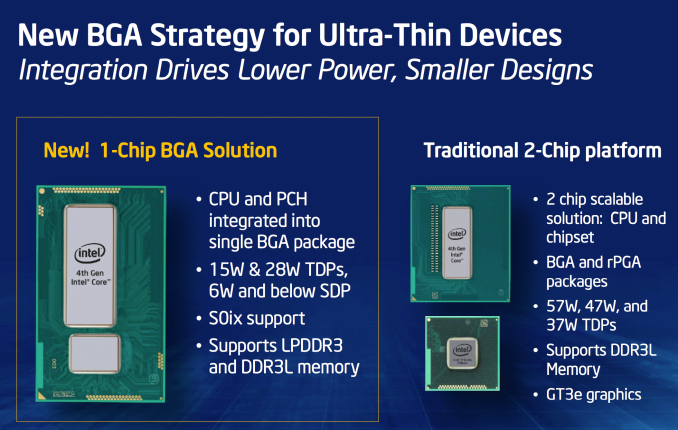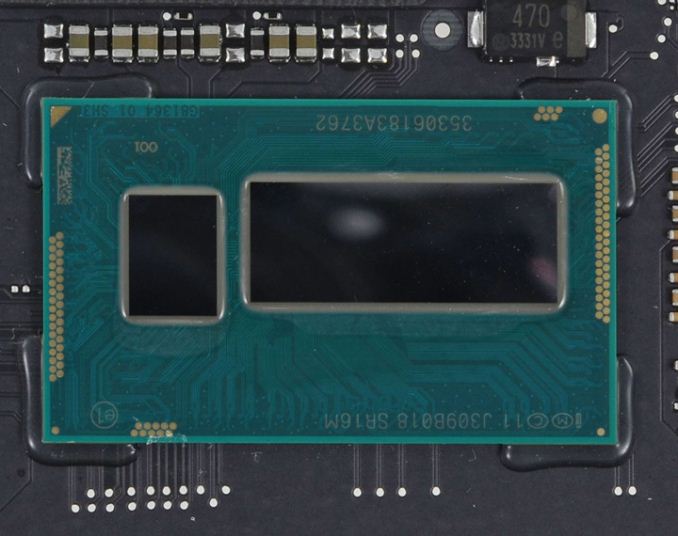The 2013 MacBook Air Review (13-inch)
by Anand Lal Shimpi on June 24, 2013 12:01 AM ESTThe CPUs
Apple keeps things simple across the 2013 MacBook Air lineup by configuring both 11 and 13-inch models with the same base CPU: a Core i5-4250U.
To understand Apple’s CPU choice, you have to understand that Apple is primarily concerned about improving battery life this generation. The line between MacBook Air and MacBook Pro has to be well defined. The Air is about portability, while the Pro is about performance. When faced with a power/performance tradeoff, it’s clear on which side of the fence Apple will fall whenever the MacBook Air is concerned.
| Apple 2013 MacBook Air CPU Comparison | |||||
| 1.3GHz dual-core | 1.7GHz dual-core | ||||
| Standard On | 11 & 13-inch MBA | Optional on Both | |||
| Intel Model | Core i5-4250U | Core i7-4650U | |||
| Base Clock Speed | 1.3GHz | 1.7GHz | |||
| Max SC Turbo | 2.6GHz | 3.3GHz | |||
| Max DC Turbo | 2.3GHz | 2.9GHz | |||
| L3 Cache | 3MB | 4MB | |||
| TSX-NI | No | Yes | |||
| TXT | No | Yes | |||
| AES-NI | Yes | Yes | |||
| VT-x/VT-x EPT | Yes | Yes | |||
| VT-d | Yes | Yes | |||
| TDP | 15W | 15W | |||
| Processor Graphics | Intel HD 5000 | Intel HD 5000 | |||
| GPU Clock (Base/Max) | 200/1000MHz | 200/1100MHz | |||
The lower base clock alone shouldn’t mean much, but the max TDP of the CPUs in the new MacBook Air falls as well - from 17W down to 15W. The thermal limit is even more dramatic since with Haswell ULT, the 15W includes the CPU/GPU as well as the on-package PCH. In Ivy Bridge the PCH was off package and wasn’t included in the 17W TDP.
Max turbo clocks are identical between the Haswell ULT CPUs Apple picked this round and the Ivy Bridge models before, but with a lower TDP it’ll be harder to always sustain the same frequencies given the right workload.
Haswell does feature a not insignificant gain in IPC compared to Ivy Bridge, which should help offset the power constraints that could otherwise force a larger regression in performance.
Both 2013 MBAs ship with the same CPU by default, and both can be upgraded to the same higher end SKU: a Core i7-4650U. The 4650U retains the same 15W TDP as the i5-4250U, but it increases its base clock speed to 1.7GHz and max turbo to 3.3GHz. The L3 cache also grows from 3MB to 4MB. All in all, this should be a very healthy upgrade in performance. Intel likely maintains the same TDP by binning for power; the i7-4650U is probably capable of running at higher frequencies without any appreciable increase in voltage. The max GPU clock also goes up by 10%.
Haswell ULT, Courtesy iFixit
What's arguably coolest about the i7-4650U is it enables Haswell's Transactional Synchronization Extensions (TSX-NI), a feature which is unfortunately disabled on the i5-4250U. I don't suspect this will matter much for most MBA users, but anyone looking to play around with Haswell's TSX instructions will want to opt for the higher end SKU. The upgrade costs $150 regardless of base model. Intel charges $454 for the i7-4650U and $342 for the i5-4250U, a difference of $112; Apple is adding another $38 onto the 1KU pricing, which isn't unreasonable.
Many have asked me what the impact of the i7 will be on battery life. I'm hoping to get my hands on an i7 based machine when I return from the UK in a week, but for those of you making immediate decisions I'll offer the following. Sustained operation at higher frequencies will likely draw more power, and negatively impact battery life. Light to medium workloads will enjoy a mix of race to sleep benefits as well as higher power consumption under load. Idle power should be roughly similar between the parts however. For most workloads I'd expect a modest impact to battery life, but it won't be enough to regress to 2012 levels of battery life. All of this is said without knowing key details like operating voltage for most 4650Us. I plan on addressing that shortly.












233 Comments
View All Comments
doobydoo - Tuesday, June 25, 2013 - link
Sigh @ Ignorant people who compare processors of different architectures by GHz.TheinsanegamerN - Sunday, June 30, 2013 - link
the boost clocks are similar, and the haswell boosts way more than ivy bridge did. look at the cpu scores, which are similar, despite the 400 mhz reduction.Krysto - Monday, June 24, 2013 - link
Disappointing to see that even Apple has started being misleading about its battery life for laptops.It seems unlike Steve Jobs, Tim Cook is more of a "regular manager" who prefer spec lists and bullet points, over being truthful to customers. Now they're just lying about battery life numbers just as every other PC OEM out there - 12h of battery life! (but you might actually get only half of that).
And all that with a CPU that is 20 percent slower than last year, and a GPU that's twice as big but only 10-20 percent better than last year.
Also, the dual core Haswell chip alone costs $350? Yikes. So you still think these chips have any chance of competing in the tablet space, Anand? The whole of iPad Mini costs less than that, with a sub $30 chip. Intel is as behind as always when it comes to competing in the mobile space.
madmilk - Monday, June 24, 2013 - link
Sheesh, at least read the review. The battery life is 11 hours on the light workload, which is certainly more than half of the advertised 12. This difference is easily accounted for by the higher screen brightness and Flash. The 1.3GHz Haswell is not 20% slower either than the comparable 1.7GHz Ivy. More like 5% at worst, and in several cases faster. The GPU is 20% faster in a _much_ lower TDP, once the FIVR and PCH are accounted for, which contributes to the very impressive battery life on the heavy workload as well. As for Haswell pricing -- ULV i5/i7 are in another league compared to any ARM offering on the market. Atoms and Celerons are more appropriate for the toy tablet market.Sushisamurai - Tuesday, June 25, 2013 - link
... If you read the fine print on apple's website, they increased the benchmark demands on the MBA compared to previous battery tests just to make the 12 hrs seem more realistic. CNET and a few other sites posted their battery tests of the 13" to be rated for 14+ hours. I think anand already made a point about this...And if you compare ARM A9's & ARM A15's performance to intel's haswell platform... You would know ARM processors really can't compete on the same level. There's a reason for that price difference
lyeoh - Monday, June 24, 2013 - link
OK, so which review site is better? So that we can go read it as well...whyso - Monday, June 24, 2013 - link
You know what would be nice. GPU benchmarks for the rmbp 13" or HD 4000 from a standard voltage part to see how it compares to the HD 5000.tipoo - Monday, June 24, 2013 - link
Agreed. It can be confusing when the ULV parts have the same name as normal TDP parts and perform significanlty differently.tecsi - Monday, June 24, 2013 - link
Could these MBAs support external 4k displays given the Intel 5000? There appears to be a new Thunderbolt part—is this Thunderbolt 2? I am surmising that this support could be turned on in MBAs when the Mac Pro arrives with Mavericks, along with potentially Apple 4k displays.tipoo - Monday, June 24, 2013 - link
Not Thunderbolt 2. Only the new Mac Pro has that right now.